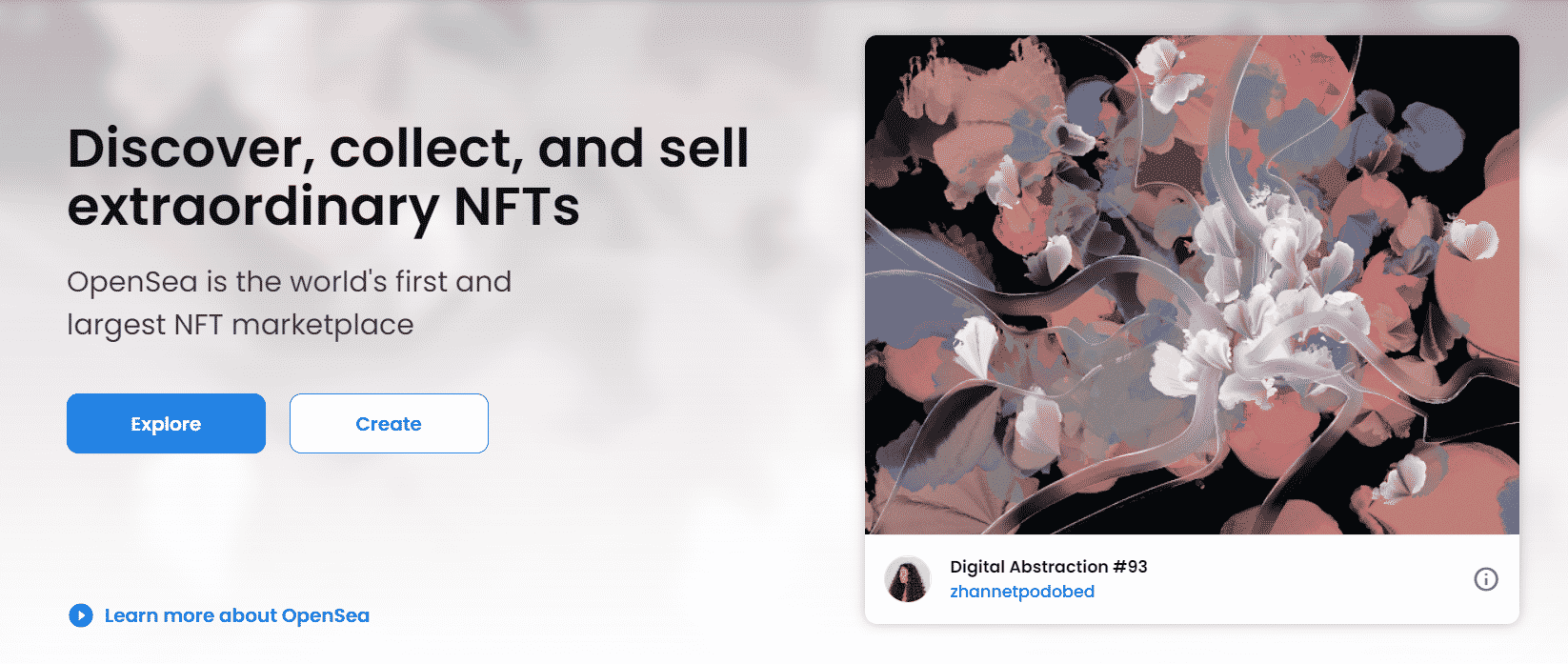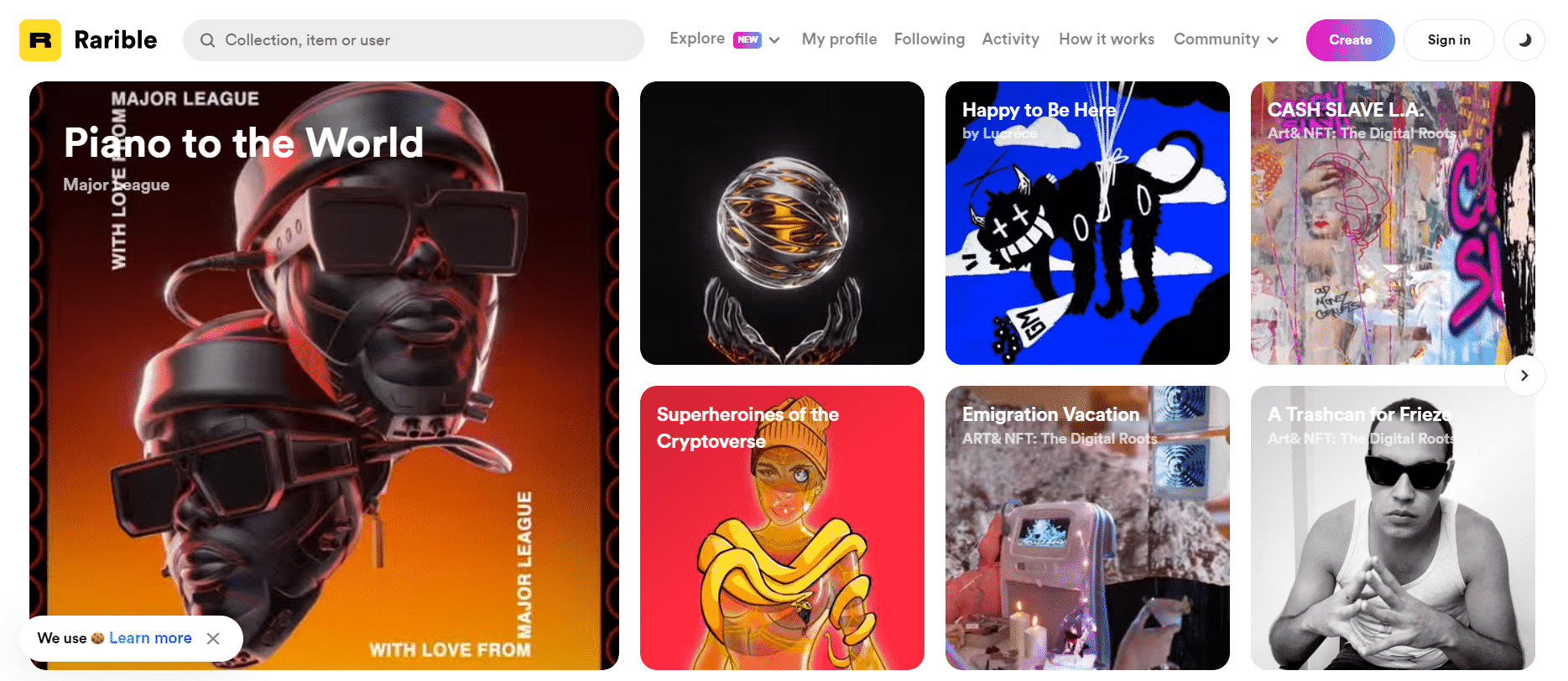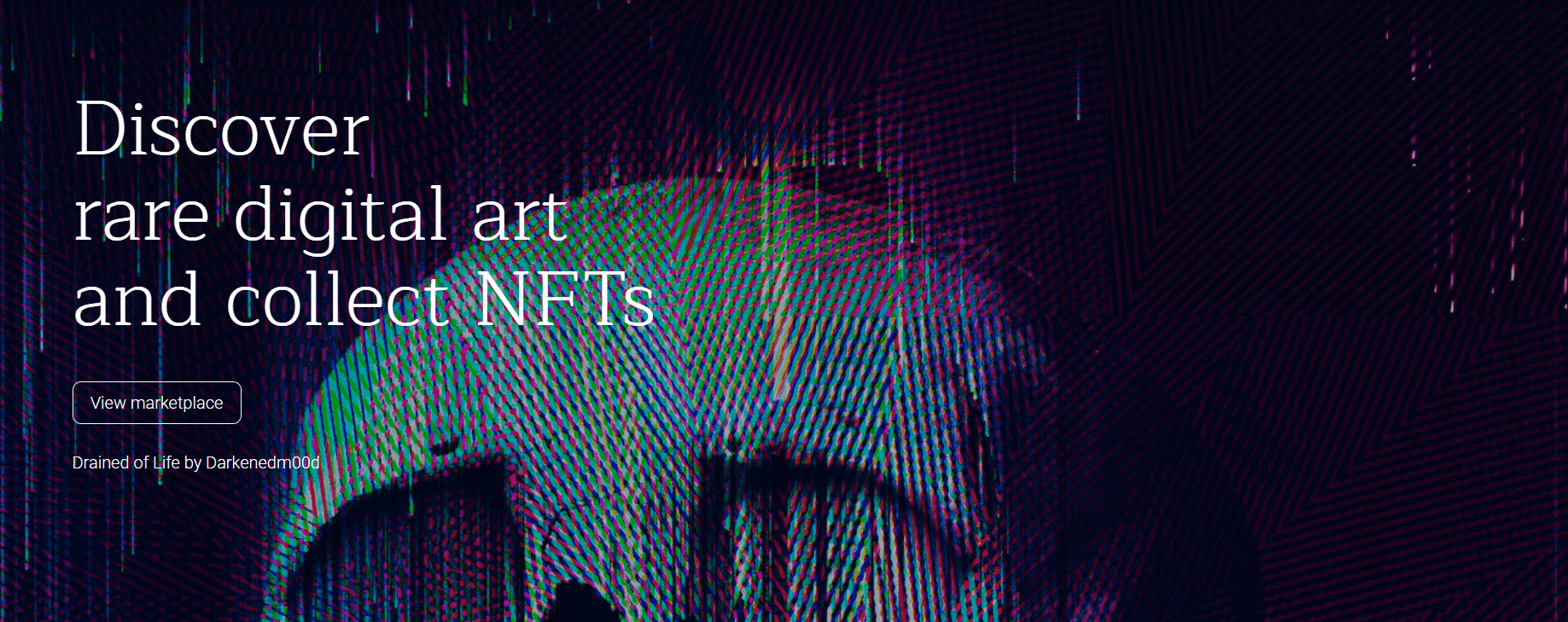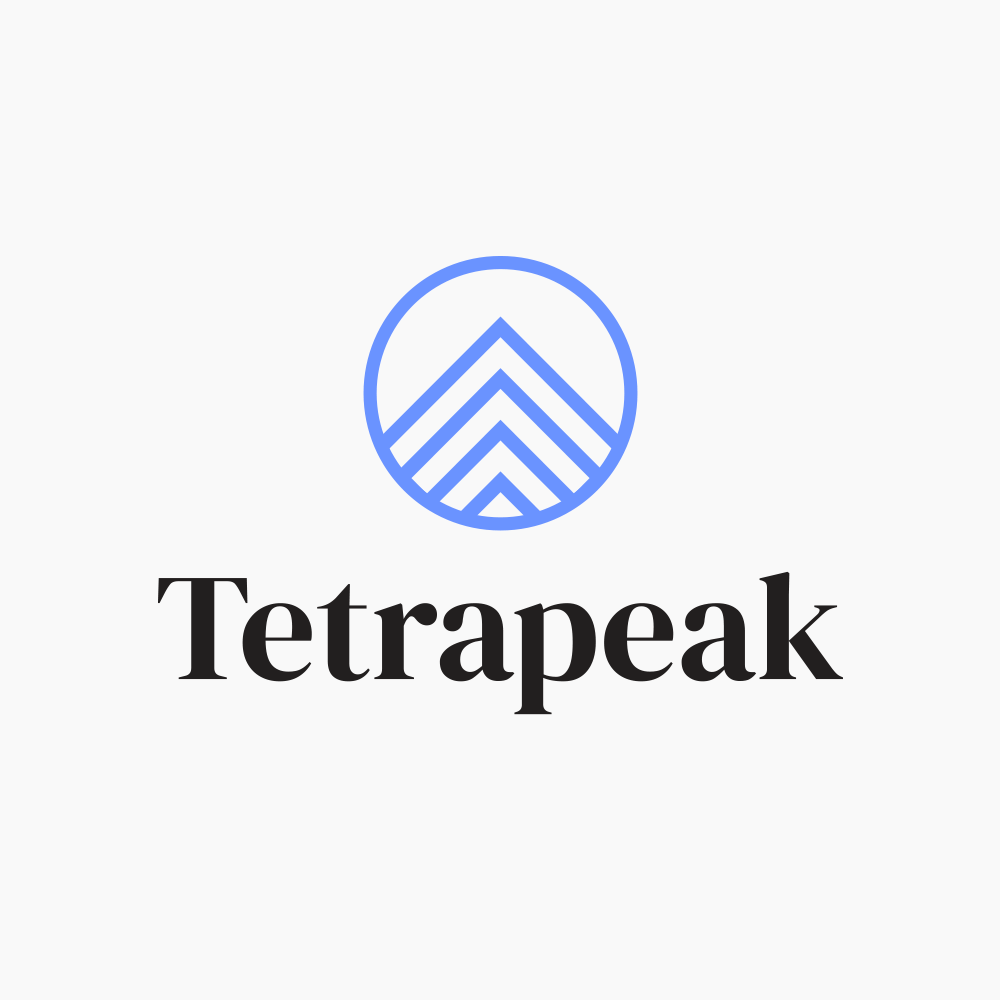Are you looking for best NFT marketplace to suit your art or design work? We share the best NFT marketplaces for artists below.
For artists, designers, and other creative people, the NFT space offers a great opportunity. Per data published by Statista, as of February 15, 2022, the aggregated NFT sales value over 30 days in the art sector worldwide amounted to around 87 million USD.

However, to succeed as an NFT creator financially, you should explore various marketplaces to see which ones best suit the types of NFTs you create. Because selecting the correct NFT marketplace could decide if your artwork sells or not.
How can you figure out which one is right for you and if you’re a newbie, where should you begin?
We have compiled a list of the best NFT marketplaces to help you make a better decision.
If you’re new to NFTs see our guides: what are NFTs and our NFT FAQs along with our NFT marketing guide.
10+ Best NFT Marketplaces for Artists
If you’re wondering where to buy NFTs in 2022, we have you covered. Here are the best NFT marketplaces ranked for you.
OpenSea

OpenSea is the largest and the most established NFT marketplace on the Ethereum blockchain. It hosts a wide range of NFT categories, from art to collectibles, virtual lands, and domain names.
- It’s an easy-to-use marketplace; you can set up your account fast.
- OpenSea is a non-exclusive platform. That means there’s no review process; you can mint your NFT and start selling immediately.
- The biggest disadvantage of OpenSea is the gas fees. Suppose it’s your first time selling an item on the platform. In that case, you need to pay for two types of transaction fees: initializing your account to enable sell orders and allowing OpenSea to access your NFT item. The second fee occurs only if you minted your NFT via a smart contract rather than the OpenSea platform.
- After these initial fees, sellers don’t pay any minting fees. So, you can mint and list as many NFTs as you like without paying for more.
- You have three listing options as a seller: fixed price, declining listing price, and auctions. Buyers can make offers even for fixed-price listings. It’s up to you to accept them.
- If your artwork sells at a fixed price, the buyer pays the gas fee when the sale occurs. But, if you accept an offer that is different than the fixed listing price, the seller must pay for it.
We also have a detailed guide on how to buy an NFT on OpenSea in case you’re interested in this platform as an NFT collector as well.
Rarible

Rarible is another NFT marketplace for selling single works of art as well as collections. Like OpenSea, it hosts NFTs from a broad range of categories.
Rarible issued its own cryptocurrency called RARI, which is a governance token. Its holders can vote on proposals for platform upgrades and participate in the NFT curations.
- Although Rarible hosts curated collections as well, it allows anyone to mint and sell NFT art. So, just like OpenSea, it’s non-exclusive.
- When you list an NFT on Rarible, it’s automatically added to OpenSea.
- The total transaction fee is 5% of the sale price. Sellers and buyers each pay 2.5% by default. Sellers can choose to pay the whole amount to make their NFTs more attractive for the buyers.
- Apart from Ethereum, Rarible also supports Flow and Tezos blockchains.
Mintable

The Mintable platform functions very similarly to OpenSea and Rarible.
- Mintable supports standard Ethereum, but it’s also integrated with the Immutable X, allowing gas-free minting. It’s completely free for sellers to mint an item.
- It’s also non-exclusive. You don’t have to undergo an approval process.
- A disadvantage is that in comparison to other platforms, there is a low amount of activity.
Foundation

Foundation is an invite-only NFT art platform. To list your NFT, a creative who has already published work on the platform must invite you.
- Your NFTs can be resold on OpenSea and Rarible, and you receive 10% royalty for each secondary sale.
- The platform charges a 15% commission rate for each sale.
- It’s less popular than the other marketplaces.
SuperRare

SuperRare is a curated platform. It only works with a small number of hand-picked artists.
- SuperRare’s focus is high-quality single-edition art NFTs.
- Only 1% of the artists’ applications are approved.
- Buyers pay the transaction fee, which equals 3% of the sale price.
- The platform charges 15% commission fees for each sale.
Nifty Gateway

Another exclusive NFT art marketplace is Nifty Gateway. It also hosts Ethereum-based NFTs. It’s challenging to get accepted to Nifty Gateway curated collections.
- They work with very famous artists like Beeple, Grimes, and Steve Aoki. They also host NFT collaborations with celebrities like the one with the artist Blake Kathryn and Paris Hilton. So, it’s very difficult to get accepted for the curated drops unless you’re really famous.
- However, there’re also verified drops on Nifty Gateway. They also require an approval process here, but it’s less strict.
- Nifty Gateway charges 5% commission fees per sale.
- Artists can set their own royalties for secondary sales.
Makersplace

Like Foundation, to list your NFT on Makersplace, you need an invitation from a member of the Makersplace community.
- Easy-to-use platform.
- It charges a 15% commission fee every time you make a sale.
- Sellers receive a 10% royalty fee from all secondary sales.
- Buyers don’t have to use Ethereum; they can also pay with a credit card.
KnownOrigin

Just like SuperRare, KnownOrigin focuses on rare and high-quality art NFTs. It’s one of the oldest NFT platforms.
- Like most of the other marketplaces, 85% of the sale is given to the NFT creator; the platform charges 15% commission fees.
- Artists earn 12.5% royalty from all secondary sales.
Most of the popular NFTs are created and sold on the Ethereum blockchain. That’s why in this article, we concentrated on the marketplaces that host Ethereum-based NFTs.
There are many other marketplaces that allow creators to sell their NFTs based on different blockchains. Some notable ones are the Binance NFT marketplace for NFTs created on the Binance Smart Chain, AtomicHub for Wax-based NFTs, and Solanart for NFTs built on the Solana blockchain.
New NFT Community for Artists, Designers & Creators
The Forest is the first NFT community for designers & creatives. The Forest is more than a community however. It is an educational platform and NFT marketplace that empowers creatives with the knowledge, connections & tools to thrive as NFT & Web3 professionals.
Reason to join: This NFT community is for artists, illustrators, and designers looking to become thriving Web3 & NFT creators and is tailored towards beginners.
Follow The Forest and JustCreativeEth on Twitter.
Frequently Asked Questions
Why does NFT art have value?
NFT art has value because they verify the authenticity of each art piece. Some people can make copies from the original one. But, using authentication check methods, they can easily figure out the original one which makes NFT arts valuable.
Can I sell pictures of my art as NFT?
NFT also allows you to sell your physical art pieces by converting them into a digital format. You can take a picture of your art and sell them in NFT marketplaces.
Is there any NFT Copyrights law?
Copyright law treats NFT artworks the same as other artworks. Once a user creates a new work, they automatically acquire the copyright of that product. So, it is clear that selling your NFT art does not transfer the NFT copyrights to the buyer. So buyers are not supposed to resell or reproduce the products in their name.
Can you get sued for selling NFT art?
When you just make a copy of the NFT art you see, it is not actually illegal. As it is easier for people to access NFT marketplaces, anyone can screenshot it for reference. But, when you try selling the NFT art pieces of other creators, it is considered illegal and you will get sued.
What is the best NFT marketplace for artworks?
Opensea is considered the best NFT marketplace for all types of NFTs and crypto-collectibles and the same goes for art as well. OpenSea allows you to browse, create, sell, auction, and buy NFT arts.
Related NFT Posts
- How To Buy NFTs
- How to Make and Sell an NFT
- Ultimate NFT Marketing Guide
- Where Do you Store NFTs?
- Frequently Asked Questions about NFTs
- Types of NFTs
Best NFT Marketplaces for Artists
NFTs or the Non-Fungible Tokens are cryptocurrency tokens that are mainly linked to the digital forms that are available online. These days you have a lot of NFT marketplaces that have come up where you can trade with NFTs that are available. We have listed a few of the NFTs market places that are available. Do you agree with us? Let us know your comments below.









